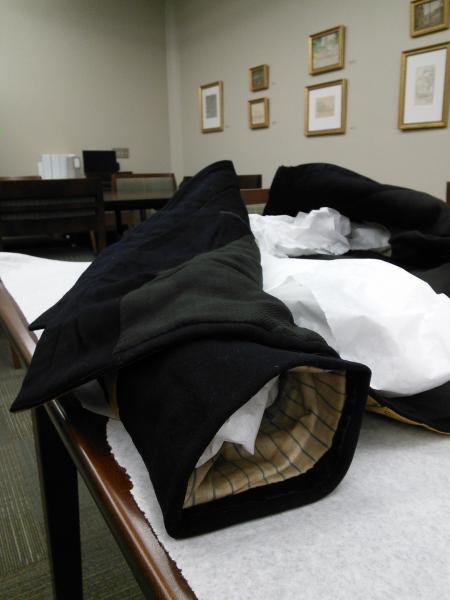Beyond the Book: Textiles
Emma Saito Lincoln, Special Collections Librarian, Augustana College
A former college president’s academic hood from 1905, a WWI-era band uniform, athletic uniforms from the 1920’s, a pair of dancing shoes from a Broadway production, silk goods collected by a missionary in China at the turn of the 20th century… These are just some of the textiles that have found their way into Special Collections at Augustana College. Like many college and university archives, our mandate to collect and preserve materials reflecting institutional history and local history has resulted in the acquisition of many items that fall into the blurry boundary between document and artifact. What do we do with these non-book, non-paper-based treasures in our collections?

The short answer is: the same thing we do with our book and manuscript collections. The broad principles of preservation such as environmental control, pest management, disaster planning, preventive conservation, etc. apply across the spectrum of materials that might live in our collections. For those who would like a refresher on the basics of library and archives preservation, the Northeast Document Conservation Center (NEDCC) offers a free introductory course called Preservation 101. The first section of Session 1: What is Preservation? provides an excellent overview. The cool, dry, stable environment that is best for books and paper is also good for textiles. Protection from light exposure? Still important. Properly sized storage enclosures made of chemically stable materials? Ditto. Even without special training in textile preservation or conservation, you probably know more than you think you do about how to properly care for these materials.
That being said, textile collections do have some needs that are distinct from book and paper collections. Museums are often equipped with extensive flat storage systems that can accommodate artifacts large and small. Libraries and archives tend to have limited capacity in their flat storage or oversized storage areas, making it difficult to store textiles flat and unfolded. At Augustana, we often have to fold items in order to fit them into boxes that will fit on our shelves. When folding is unavoidable, we minimize creasing and damage to fibers by supporting three-dimensional features and padding folds with acid-free tissue paper.




Most librarians and archivists have a sharp eye for damaged or tight bindings, brittle pages, and other visible evidence of fragility in our book and paper collections. Textiles, however, are often more fragile than they appear, and can be easily damaged by routine handling or improper display techniques. For guidance on safe methods for handling and display, see the resources below. When in doubt, consult a textile conservator for an expert opinion. If you do not know any textile conservators, consult the Find-a-Conservator directory from the American Institute for Conservation of Art and Historic Works (AIC): http://www.conservation-us.org/membership/find-a-conservator/.
Resources:
American Institute for Conservation of Art and Historic Works, Caring for Your Treasures: Textiles
Canadian Conservation Institute, CCI Notes, Series 13, Textiles and Fibres
Smithsonian Museum Conservation Institute, How to Handle Antique Textiles and Costumes
Winterthur Museum, Care in Handling, Chapter 2, Textiles
Minnesota Historical Society, Storage of Heirloom Textiles Podcast Series
National Park Service, Museum Handbook, Appendix K, Curatorial Care of Textile Objects
Return to Beyond the Book: Preserving your Non-Book Collections

